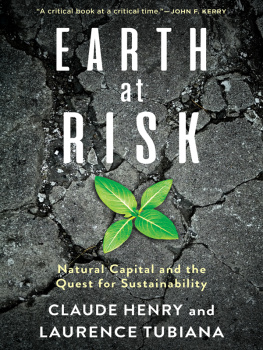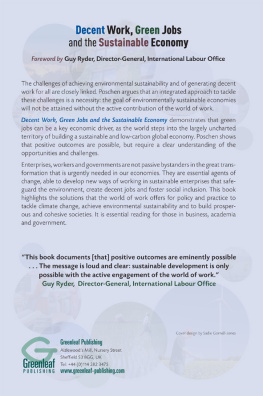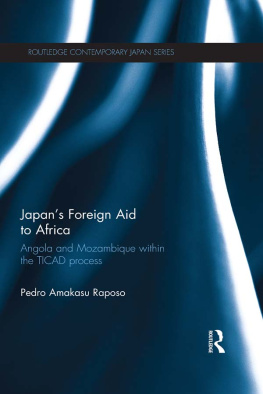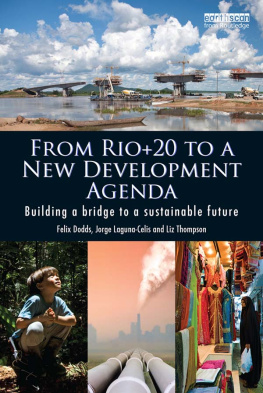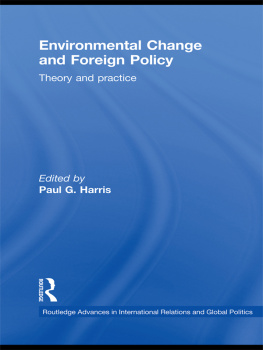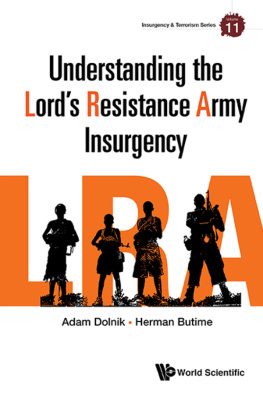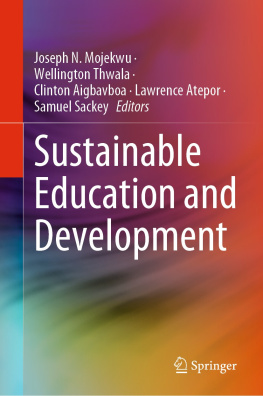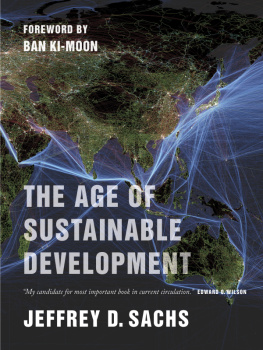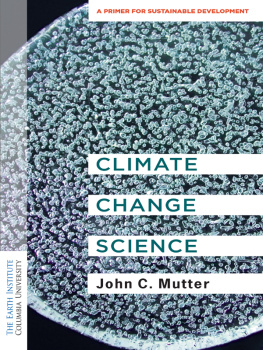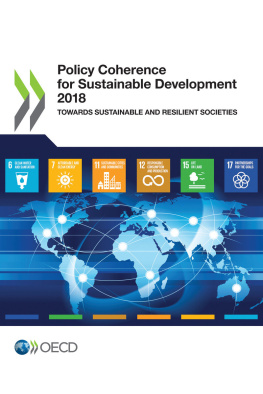Table of Contents
EARTH AT RISK
CLAUDE HENRY AND LAURENCE TUBIANA
EARTH AT RISK
Natural Capital and the Quest for Sustainability
COLUMBIA UNIVERSITY PRESS
NEW YORK
Columbia University Press
Publishers Since 1893
New York Chichester, West Sussex
cup.columbia.edu
Copyright 2018 Columbia University Press
All rights reserved
E-ISBN 978-0-231-54491-7
Library of Congress Cataloging-in-Publication Data
Names: Henry, Claude, author. | Tubiana, Laurence.
Title: Earth at risk : natural capital and the quest for sustainability / Claude Henry and Laurence Tubiana.
Description: New York : Columbia University Press, 2017. | Includes bibliographical references and index.
Identifiers: LCCN 2017026502 | ISBN 9780231162524 (alk. paper)
Subjects: LCSH: Sustainable development. | Natural resourcesManagement. | Global environmental change.
Classification: LCC HC79.E5 H463 2017 | DDC 338.9/27dc23
LC record available at https://lccn.loc.gov/2017026502
A Columbia University Press E-book.
CUP would be pleased to hear about your reading experience with this e-book at .
Cover design: Noah Arlow
This is only the first sip, the first foretaste of the bitter cup which will be proffered to us year by year, unless by a supreme recovery of moral health and martial vigour, we arise again.
Winston Churchill, On the Munich Agreement, House of Commons, October 5, 1938
CONTENTS
B OTH KEN ARROW and Tony Atkinson are present in the book, and to both we owe illuminating suggestions as well as friendly encouragement; neither is still with us, albeit they remain deep in our hearts.
This book would not have been possible without the interactions with our students at Columbia University, the Institut dEtudes Politiques de Paris, and Ecole Polytechnique Paris. They had previously graduated in all kinds of subjects, and they were all new to the approach taken here. That required us to make constant effort to clarify both our conceptual clarity and our pedagogy, as well as to achieve an appropriate balance among conceptual developments, illustrations, and applications. These efforts should make the book accessible and attractive to larger audiences of readers interested in the issues discussed.
We are also much indebted to Michel Balinski, Pierre Barthlemy, Jean-Pascal Benassy, Michel Berry, Isabelle Biagiotti, Dominique Bureau, Damien Conare, Michel Colombier, Pierre Ducret, Anne-Laure Faure, Emmanuel Guerin, Alain Grandjean, Geoffrey Heal, Jean Jouzel, David Kennett, Jean-Christian Lambelet, Yann Laurens, Valrie Masson, Franois Moisan, Pippo Ranci, Vincent Renard, Nicholas Stern, Thomas Sterner, Sbastien Treyer, and Tancrde Voituriez.
Support is gratefully acknowledged from the Institut du Dveloppement Durable et des Relations Internationales (Paris), with Lisa Dacosta and Laetitia Dupraz; from the Chaire du Dveloppement Durable at Ecole Polytechnique (Paris), with Lyza Racon; and from the Alliance Programme (New York and Paris), under Alessia Lefbure.
At Columbia University Press, Bridget Flannery-McCoy and Marielle Poss were in charge of steering the manuscript toward its final form, and Ben Kolstad of Cenveo oversaw the production. We had not imagined how crucial their contributions would be. Bridget in particular suggested how to properly structure an initially disorganized text, and she helped prune unnecessary material. Ben not only clarified the formulation but also sought precision everywhere it was somewhat lacking.
W HY SHOULD we muster the best of our resourcesboth human and materialto implement a more sustainable form of development? The answer is that billions of our fellow humans live in extreme poverty, and this will not change without deeply changing the present mode of development. Moreover, the condition of our planet worsens at such a pace that all forms of life, including ours, will come under the most serious threats during the present century. Current generations are squandering, at an unbearable pace, the heritage of natural capital in their hands, and poor communities are suffering and will suffer most.
a framework and a springboard for promoting, sanctioning, and coordinating all sorts of actions aimed at containing climate change.
NATURAL CAPITAL DEVASTATION
In an unusual statement on the eve of the 2012 Rio+20 Conference, the editors of Nature reminded their readers:
The most unique feature of Earth is the existence of life, and the most extraordinary feature of life, is its diversity. Approximately 9 million types of plants, animals, protists, and fungi inhabit the earth. So, too, do 7 billion people. Two decades ago, at the first Earth Summit, the vast majority of the worlds nations declared that human actions were dismantling the Earths ecosystems, eliminating genes, species and biological traits at an alarming rate. This observation led to the question of how such loss of biological diversity will alter the functioning of ecosystems and their ability to provide society with the goods and services needed to prosper (Cardinale et al. 2012, 59).
Needless to say, the rate of dismantling is no less alarming today than it was two decades ago. Marine ecosystems are in such danger that it is no longer absurd to envisage biodiversity at sea reduced to the diversity of jellyfish varieties. Rain forestsunder the pressures of palm oil production, soybean farming, beef ranching, wood smuggling, legal and illegal mining, pervasive greed, corruption, banditism, and even warfarefare no better than the oceans. Nor are temperate forests immune to degradation; in northwestern America and across Siberia, fungi, beetles, and fires, whipped up by climate change, conspire in a mass extermination of trees. (We will consider biodiversity erosion further in .)
Water and soil have in common an essential trait: both are subject to enormous waste. Irrigation accounts for two-thirds of the total quantity of water used by human beings. One-half of this, or fully one-third of the total, is lost. In many places, from Texas to Punjab, farmers pump as much water as they can from fast-declining aquifers, convinced that any drop they fail to extract will be pumpedexpropriated, as they see itby their neighbors.
Dominant approaches to soil management are just as reckless, as exemplified by the way nitrogen fertilizers are applied. In Europe and the United States, only about 20 to 30 percent of the amount of nitrogen applied to the fields is actually taken up by the plants. In China, it is even less. The surplus not only pollutes both air and water but also acidifies soils, which becomes toxic to crops. This is one of the main reasons, according to a report on November 4, 2014, by Xinhua, the official press agency of the Peoples Republic of China, why more than 40% of China's arable land is suffering from degradation, seriously reducing the country's capacity to produce food for the world's biggest population. (More on water and soil waste in .)
While scarcity of clean water and arable soil is a pending disaster, a resource for which greater scarcity would be welcome is fossil fuels. Scientists not only agree that carbon release is the main cause of global warming; most now say that to avoid major climate disturbances, the increase in the earths mean temperature must be kept under 1.5C2C (compared with preindustrial levels). This requires leaving at least two-thirds of all proven conventional fossil fuel reserves in the ground and not tapping shale, deep sea, or Arctic reserves. As the executive summary to the 2012 International Energy Agencys

